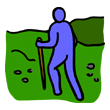Study the following pairs of sentences.
|
|
- A- Nem' 'u tseep 'umshasum'?
|
Are you (pl.) going to go for a walk? |
- B- Hee'. Nem' tst ('umshasum').
|
Yes. We are going (for a walk). |
|
|
Are you (pl.) coming to work? |
- B- Hee'. M'i tst (yaays).
|
Yes. We are coming (to work). |
- A- Hwts'e'nutsum 'u tseep tse'?
|
Will you (pl.) sit down? |
- B- Hee'. Hwts'e'nutsum tst tse'.
|
Yes. We will sit down. |
|
Use the second person plural subject pronoun tseep when addressing more than one person. Place tseep after the first auxiliary or verb of the sentence.
| Nem' tseep 'umshasum'. |
"You (pl.) go for a walk." |
| M'i tseep yaays. |
"You (pl.) come to work." |
| Hwts'e'nutsum tseep tse'. |
"You (pl.) will sit down." |
Place the first person plural subject pronoun tst after the first auxiliary or verb.
| Nem' tst 'umshasum'. |
"We are going for a walk." |
| M'i tst yaays. |
"We are coming to work." |
| Hwts'e'nutsum tst tse'. |
"We will sit down." |
When forming a question, the interrogative particle 'u precedes tseep.
| Nem' 'u tseep 'umshasum'? |
"Are you (pl.) going for a walk?" |
| M'i 'u tseep yaays? |
"Are you (pl.) coming to work?" |
| Hwts'e'nutsum 'u tseep tse'? |
"Will you (pl.) sit down?" |


